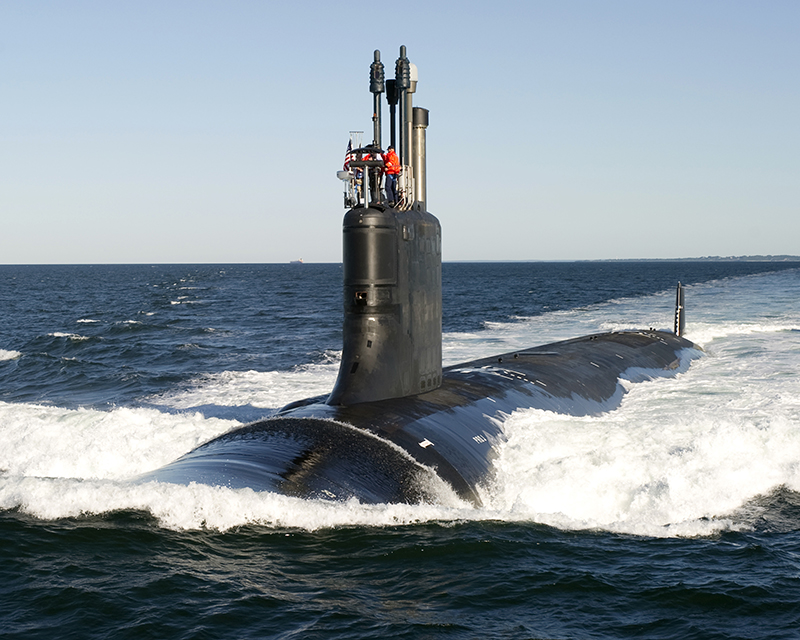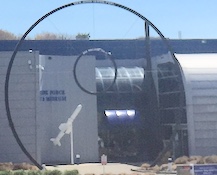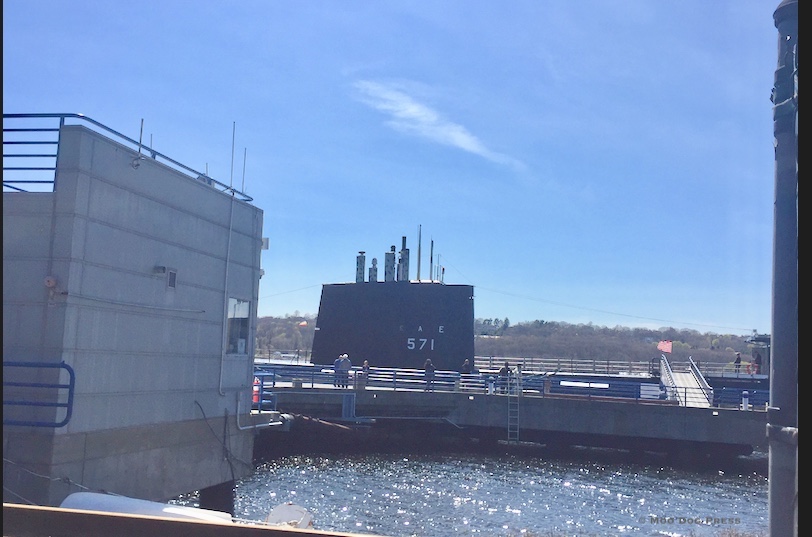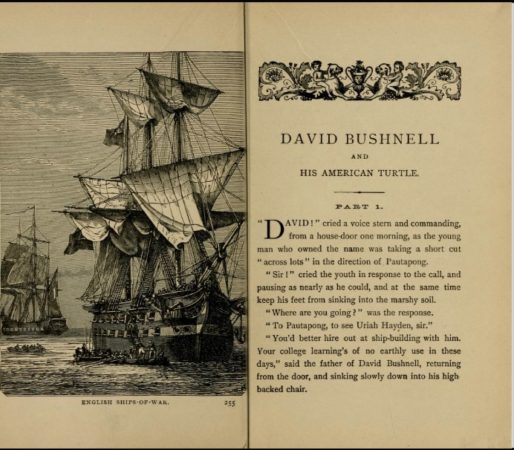Then and Now: Bushnell’s Turtle To General Dynamic Electric Boat
“On a quiet September night in 1776, sergeant Ezra Lee maneuvered Bushnell's strange little craft out from Manhattan and into the midst of the greatest naval fleet ever assembled in the Americas.”
— from the flyleaf of Turtle: David Bushnell's Revolutionary Vessel by Roy R. Manstan and Frederic J. Frese.
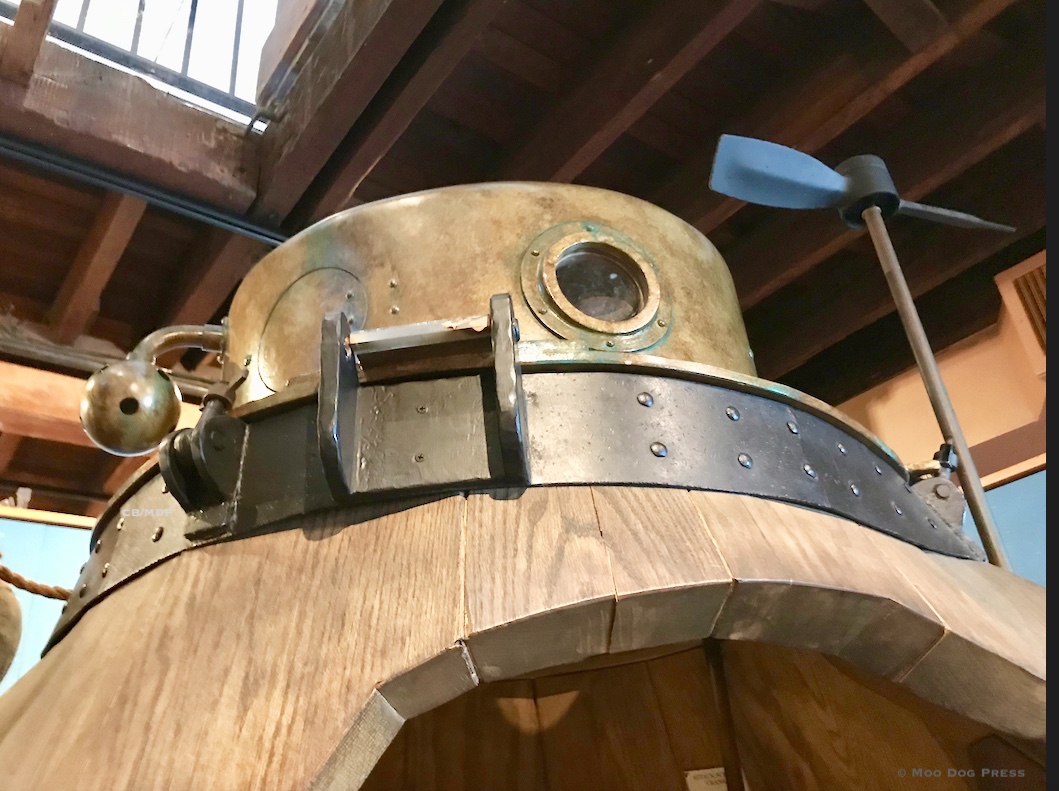
Then. The top section of the Turtle exhibit at Connecticut River Museum. A full-size cutaway replica.
In darkness and under water, light and mechanical inventions for stealth and defensive maneuvers with a human at the controls. In 1776.
For archives of the Connecticut River Museum (CRM), this description: “Working full-size model of Revolutionary War submarine TURTLE; built by Fred Frese of East Haddam and Joe Leary of Fairfield during the US Bicentennial; christened by Gov. Ella Grasso and launched at the Connecticut River Museum August 20, 1977 (value $40,000). Catalog Number: 79.0011. Object name: Turtle.”
“Bushnell was never specific about the materials he used for illumination, only mentioning that he applied ‘phosphorus' to his compass and depth gauge.
…
“A material that flowed with no flame or heat and could sustain its illumination without any apparent consumption of air was a mystery that begged for an answer. It had been a curiosity among scientific minds throughout history.”
— page 125 Turtle: David Bushnell's Revolutionary Vessel by Roy R. Manstan and Frederic J. Frese (2010) about the “remarkable history and reconstruction of the first operational submarine,” published by Westholme Publishing of Pennsylvania.
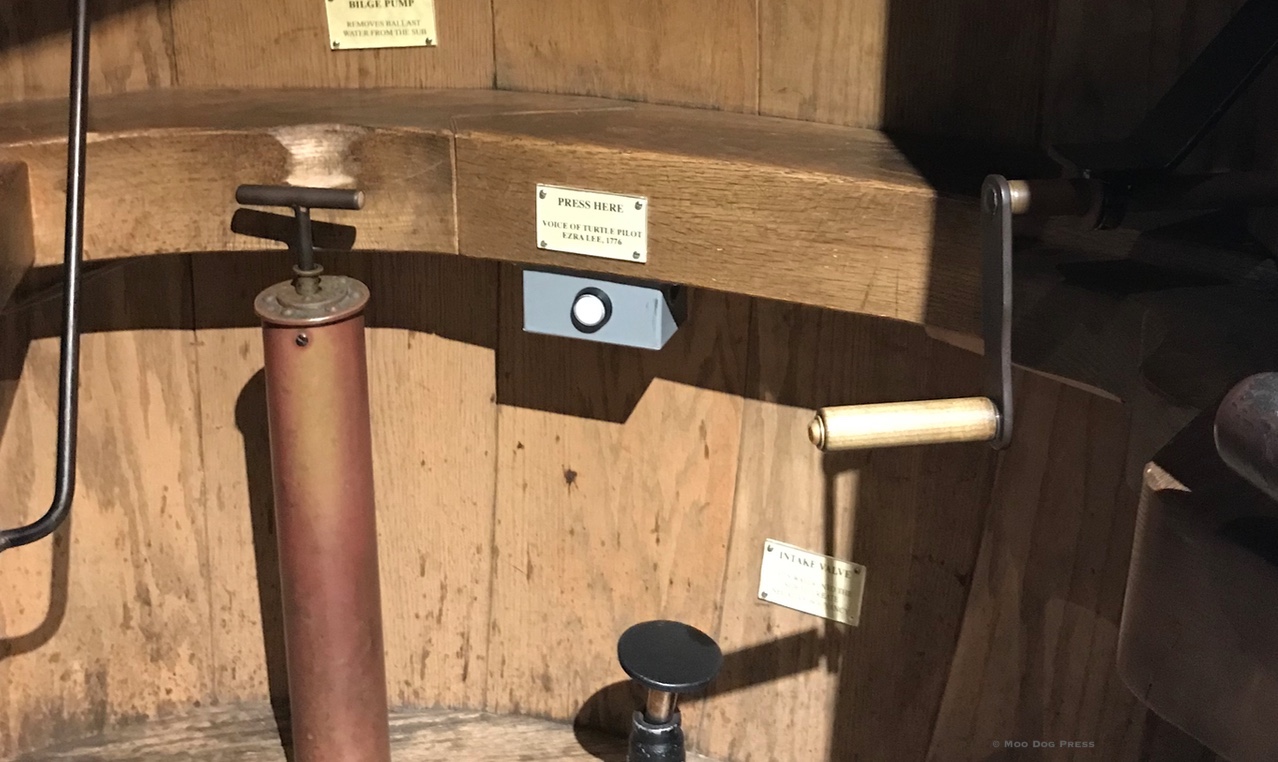
“Press here, voice of Turtle pilot Ezra Lee, 1776…” and components inside the replica vessel for visitors to explore.
Visitors can sit inside the cutaway replica of the Turtle at the museum and explore the workings and engineering of the vessel. (May the experience inspire more than awe of the inventor and the operators.)
And now, fast forward to excerpts from an official press release (Sept. 13, 2019) – General Dynamics (NYSE: GD) has appointed General Dynamics NASSCO president Kevin Graney as president of General Dynamics Electric Boat, effective Oct. 1. David J. Carver, NASSCO’s vice president and general manager of repair, will succeed Graney as president of General Dynamics NASSCO. Geiger, who has served as president of Electric Boat since 2013, will retire effective Sept. 30.
Graney began his shipbuilding career with General Dynamics Electric Boat in 1995 as a senior engineer for the Virginia-class submarine program and worked in various leadership roles at General Dynamics before becoming president of NASSCO in 2017. Carver joined NASSCO in 1987 and has served in his current position since 2014, where he has been responsible for production, engineering, purchasing, subcontracts administration, contracting and estimating of repair activities.
Headquartered in Reston, Virginia, General Dynamics is a global aerospace and defense company that offers a broad portfolio of products and services in business aviation; combat vehicles, weapons systems and munitions; IT services; C4ISR solutions; and shipbuilding and ship repair. General Dynamics employs more than 100,000 people worldwide and generated $36.2 billion in revenue in 2018.
Related: Electric Boat Breaks Ground on Construction Facility for New Class of Ballistic Missile Submarines (also Sept. 13, 2019) Electric Boat employees joined state, local and federal officials today at the company’s Groton Shipyard to mark the groundbreaking of a new facility dedicated to construction of the Columbia class of submarines.
“This expansion will be the largest construction project to take place at EB’s Groton shipyard in more than 45 years,” said Jeffrey Geiger, president, General Dynamics Electric Boat. “The facility we break ground on today will enable Electric Boat to deliver the U.S. Navy’s number-one acquisition priority—the Columbia class—our nation’s next-generation fleet of ballistic missile submarines.”
The South Yard Assembly Building (SYAB), a 200,000 square-foot building, will eventually be home to 1,400 skilled shipbuilders who will deliver the Columbia class to the U.S. Navy. The SYAB is the centerpiece of an $850 million expansion at the company’s Groton Shipyard. The company will also expand and update other manufacturing spaces and build a floating dry dock to launch Columbia submarines.
AECOM of Los Angeles, California is the construction manager for the project. Gilbane Building Company of Providence, Rhode Island is the project manager and Jacobs Engineering Group of Dallas, Texas, is the design firm.
In total, General Dynamics Electric Boat will invest more than $1.7 billion to modernize and upgrade its facilities over the next decade. In addition to the facilities in Groton, the company is investing $700 million at its location in Quonset Point, Rhode Island. Earlier this week, the company announced that it had completed construction of a facility at Quonset Point to support construction of a payload module to expand length, capability and capacity of Virginia class fast-attack submarines.
The investments in facilities are part of a broad company effort to respond to the expanded needs of the Navy. The company has hired about 14,000 new employees in the last eight years, and has made sizable investments in onboarding and training these employees who design, build and test the world’s most capable submarines. Electric Boat has worked with its national network of suppliers to prepare for the 2.5 times increase in need for supplies and materials to concurrently build the Columbia and Virginia classes.
General Dynamics Electric Boat has a workforce of more than 17,000 employees at its three primary locations in Groton and New London, Connecticut, and Quonset Point, Rhode Island. General Dynamics Electric Boat is a business unit of General Dynamics (NYSE: GD). Headquartered in Reston, Virginia, General Dynamics is a global aerospace and defense company that offers a broad portfolio of products and services in business aviation; combat vehicles, weapons systems and munitions; IT services; C4ISR solutions; and shipbuilding and ship repair. General Dynamics employs more than 100,000 people worldwide and generated $36.2 billion in revenue in 2018.
And this from Sept. 11, 2019: General Dynamics Electric Boat announced that it has completed construction of the Virginia Payload Module (VPM) Special Fixture building, a 30,000 square-foot, $28 million facility at the company’s Quonset Point location which will support construction of the nation’s newest attack submarines. Additionally, the company will break ground Friday on a 200,000 square foot building in Groton, Connecticut, that will be used to construct Columbia-class ballistic missile submarines.
The VPM building is part of a $700 million investment General Dynamics announced last year to increase by 13 acres hull-outfitting space for the Virginia- and Columbia-class submarines at Quonset Point. When complete, the entire complex will add 575,000 square feet to the Rhode Island campus, representing one of the largest construction projects undertaken in the state in recent years. About 600 jobs will be created to support the construction of these new facilities.
…
In addition to infrastructure investments, the company has hired 14,000 new employees in the last 8 years and has made sizable investments in training employees, who design, build and test the world’s most capable submarines. Electric Boat is also working with its national network of suppliers to prepare for the 250 percent increase in supplies and materials required to concurrently build the Columbia and Virginia class.
Note: Related and rich in history, the Submarine Force Library & Museum and USS Nautilus in Groton, Connecticut, is the only submarine museum operated by the U.S. Navy. Not only are the exhibits interesting (development of the “Silent Service” from David Bushnell's Turtle, used in the Revolutionary War, to the Ohio and Virginia class submarines), but also for the tour (free) aboard the Nautilus. Views of the Thames River are inspiring. Drive to the museum and parking and be sure to notice the active USN base and gate area. Link to the Facebook page for hours of operation and a preview, here.
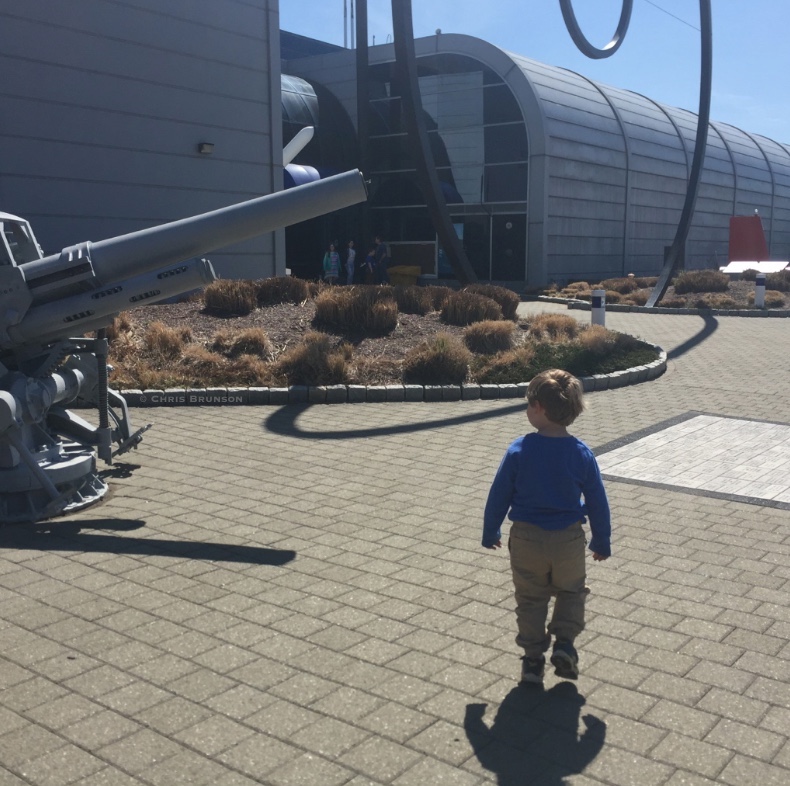
Much to see at the Submarine Force Museum, inside and out. Plus the Nautilus tour, which is amazing.

On any given day, fellow travelers hail from around the country and many times, from around the globe.
History from the official site: “Originally established as ‘The Submarine Library' by Electric Boat Division of General Dynamics Corporation in 1955, the Submarine Force Library and Museum soon gained respect for its archival and research value. In April 1964, the entire collection was donated to the Navy and relocated to the Naval Submarine Base, New London, Groton, Connecticut. The name ‘Submarine Force Library and Museum' was officially adopted in 1969.
“The museum's collections include more than 33,000 artifacts, 20,000 significant documents and 30,000 photographs. With so many holdings, the displays change frequently and a return visit will be a new experience. The 6,000 volume reference and research library is a world-renowned collection relative to the history of U.S. submarines and is open to anyone looking for information on submarines or submarine history.”

The cover of the book Turtle: David Bushnell's Revolutionary Vessel by Roy Manstan and Frederic Frese. Published by Westholme Publishing.
For those who enjoy another view and the mention of Connecticut place names, the Library of Congress (LOC) offers a digitized version of the 70-page Bushnell and his American Turtle (1899). And to find out what happened to Ezra Lee on his mission in 1776, consider requesting Turtle: David Bushnell's Revolutionary Vessel by Roy R. Manstan and Frederic J. Frese at your local library or find it in a local bookstore. It's a good book, and a great true-life story.


